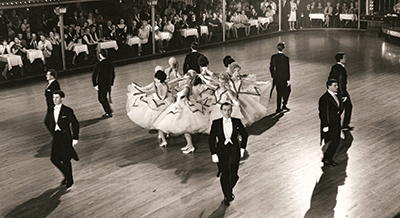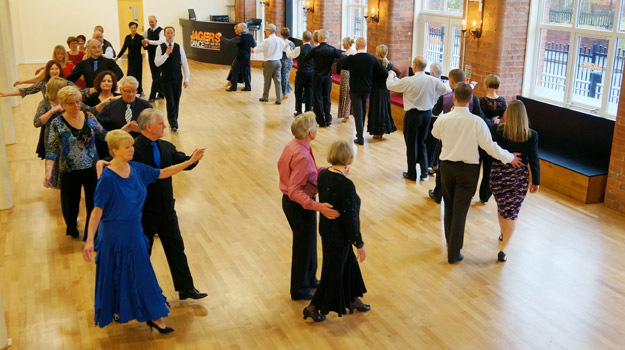Sequence Dancing
See also: Categories: Dances, Ballroom, DanceSport, Dance Styles
Definition
Overview
Sequence dancing, in general, is much older than modern Ballroom dancing. With the exception of the Waltz, invented around 1800, all dances in Ballrooms were sequence dances until the early 20th century. After modern Ballroom dancing developed, in England, sequence dancing continued. It included the so-called "Old Time" dances and also adapted versions of the new Ballroom dances and then versions of the Latin dances.Sequence dancing is a competitive sport as well as a social pastime.
The British Sequence Championships is the most famous annual sequence dance competition and is part of the Blackpool Sequence Dance Festival. This event has been held in the Empress Ballroom at the Winter Gardens in Blackpool, England, since 1949.
Tempo, Rhythm, and Music
Modern sequence dancing has a repeat of the steps at every sixteenth bar, typically going on for five or six sequences in all. Specially performed sequence dance music in strict tempo is usually needed, although some 'ordinary' music may suffice provided it is played in 16 bar sections or sequences throughout. Ideally, sequence music will have a four bar introduction at the correct tempo and in the correct rhythm, followed by 5 or 6 sixteen bar sequences allowing all dancers to progress around the room and ending when the music finishes.There are many different tempo types for sequence dancing, based on the classification of each dance. Each has an accepted speed of playing so that a typical program of sequence dancing has a wide variety of activity.
A Variety of Dances
Sequence dances are split into 3 different sections: "Old Time", also occasionally seen as "Old Tyme" (now referred to as "Classical"), "Modern", or "Latin", with the dividing line being somewhere in the early 20th century. Here are some examples:- Latin American Dances:
New sequences are being devised all the time and the number which have been published as scripts as of 2010, is standing at over four thousand.
Regular competitions are held between dance teachers to decide which newly created sequence dances shall be "officially" adopted and scripted for wider distribution. Most of these are tried for a short while and then disappear into the archives. Some, just a few, find great popularity and join the select group of dances which last for several years around the dance halls. Such popular dances are the basis of practically every "Tea Dance". Moreover, most now consider that the best dances are the older dances, and although a few clubs still teach them, interest in the new dances now seems to be rapidly diminishing.
Most people who attend these functions will recognize sequences such as the Saunter Together, Mayfair Quickstep, Catherine Waltz, Rumba One and many others. An alternative to the Tea Dance is the Sequence Dancing Club. These are devoted to the teaching and learning of all the approved new sequence dances.
New Vogue
New Vogue is a set of sequence dances which use modern Ballroom technique. It was developed in Australia in the 1930s and is danced socially and competitively across Australia and New Zealand. There are fifteen competition dances which cover the March, Foxtrot, Tango and Viennese Waltz rhythms.Sequence Dancing Scripts
Scripts are the written-down versions of each Sequence Dance. They are written in a shorthand form similar to phone texting or knitting patterns. The jargon is easily learned and the shorthand can be understood. Ultra keen sequence dancers subscribe to script services that distribute the scripts immediately as they are issued by competition organizers. A short example of this dance scripting is as follows:- 1. RF Fwd in CBMP (OP) comm to tn R. Side LF. Cls RF to LF to end bkng LOD. S Q Q.
- 1 Translation: Right foot forward in CBMP (Contra-Body Movement Position), outside partner, commence to turn right. Left foot to side. Close right foot to left foot to end backing line of dance. Slow, quick, quick
- 2. LF bk dn LOD. RF Bk, R shldr ldg. Crs LF in front of RF S Q Q.
- 2 Translation: Left foot back down line of dance. Right foot back, right shoulder leading. Cross left foot in front of right foot. Slow, quick, quick
Social Element
Go to any sequence dance yourself and you will find that most attendees are retired persons who find it a low-cost and pleasant social occasion. They like the older tuneful melodies on which the dance music is based, and the modest exercise is good for health.Practically all sequence dancers have a good sense of humor, and this is shown in the many self-parody leaflets which go around the dance halls in the public domain. The following poem is an example:
- It's the Sunday tea dance, and they'll all be here today,
- Aches and pains forgotten, dance the afternoon away.
- Foxtrots, quicksteps, waltzes, some are slow but some still nifty,
- With memories of how it was way back in 1950.
- Norman's in the toilet and he's struggling to pee,
- He's got trouble with his prostate, and he'll likely miss his tea.
- Eddy's got a new love that he met in Thornton Heath,
- She does a lovely tango, but she hasn't any teeth.
- His latest fancy footwork nearly broke his partner's neck,
- She mistook his outside swivel for a travelling contra check.
- Ida's had her hair done and she's ready for the saunter,
- She had a vindaloo last night and it's coming back to haunt her.
- Florry's mini-skirt's revealing when she's spinning in the jive,
- She really shouldn't wear a thong, approaching 85.
- They've had their tea and cake and chat and had a little laugh,
- And gamely rise with creaking knees to face the second half.
- Norman's made it back in time for rumba number one,
- His cucaracha's very neat, but he's left his flies undone.
- Vera's fallen over in a massive Crimplene heap,
- Bert's got indigestion and Mabel's fast asleep.
- It's last waltz time and up they get
- For Humperdinck's old tune,
- And then: 'Goodbye, good luck, take care,
- God willing see you soon.'
- Derek Prothero, Surrey.
(Note: Humperdinck's old tune refers to "I Had the Last Waltz With You", a 1960s hit melody.)






